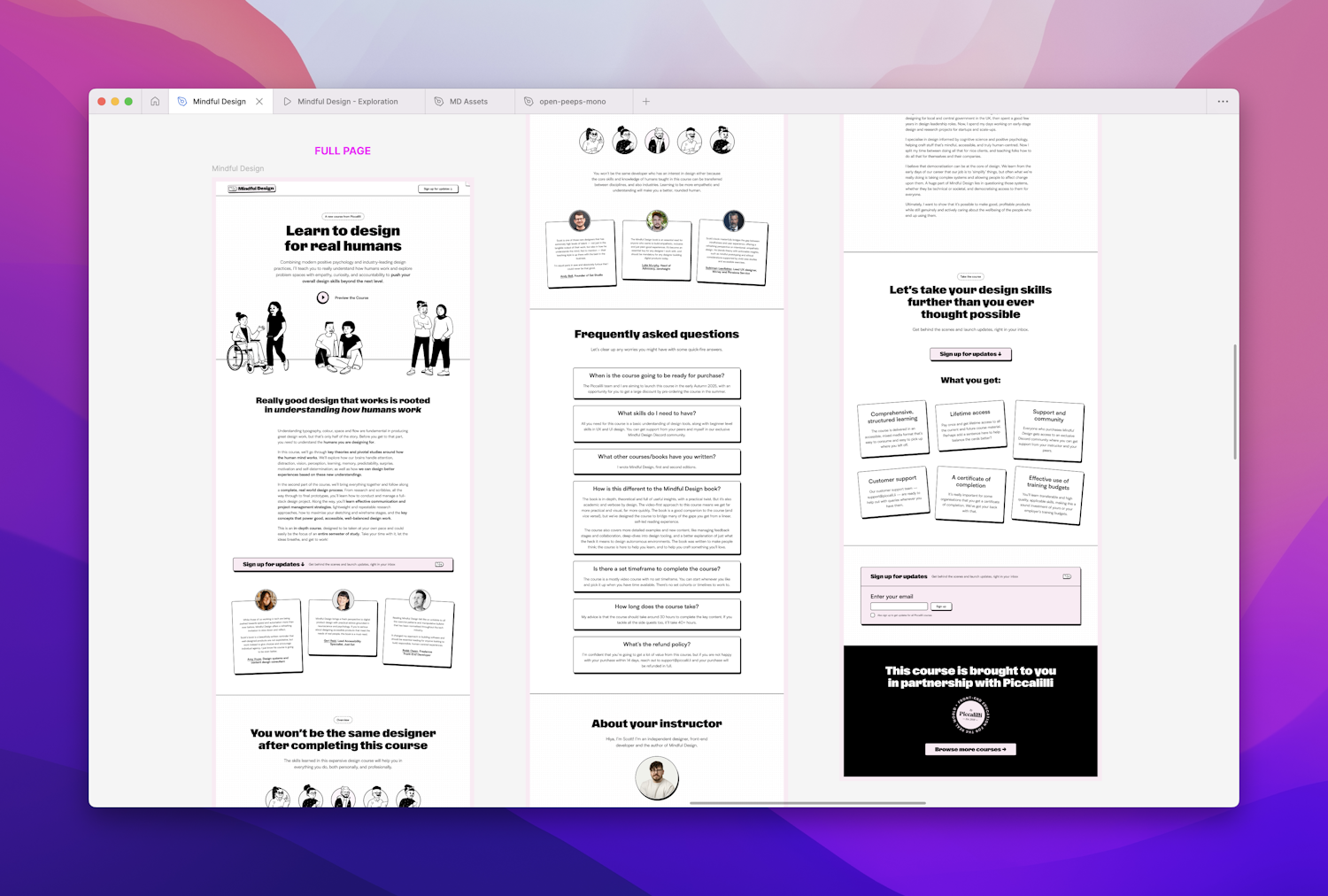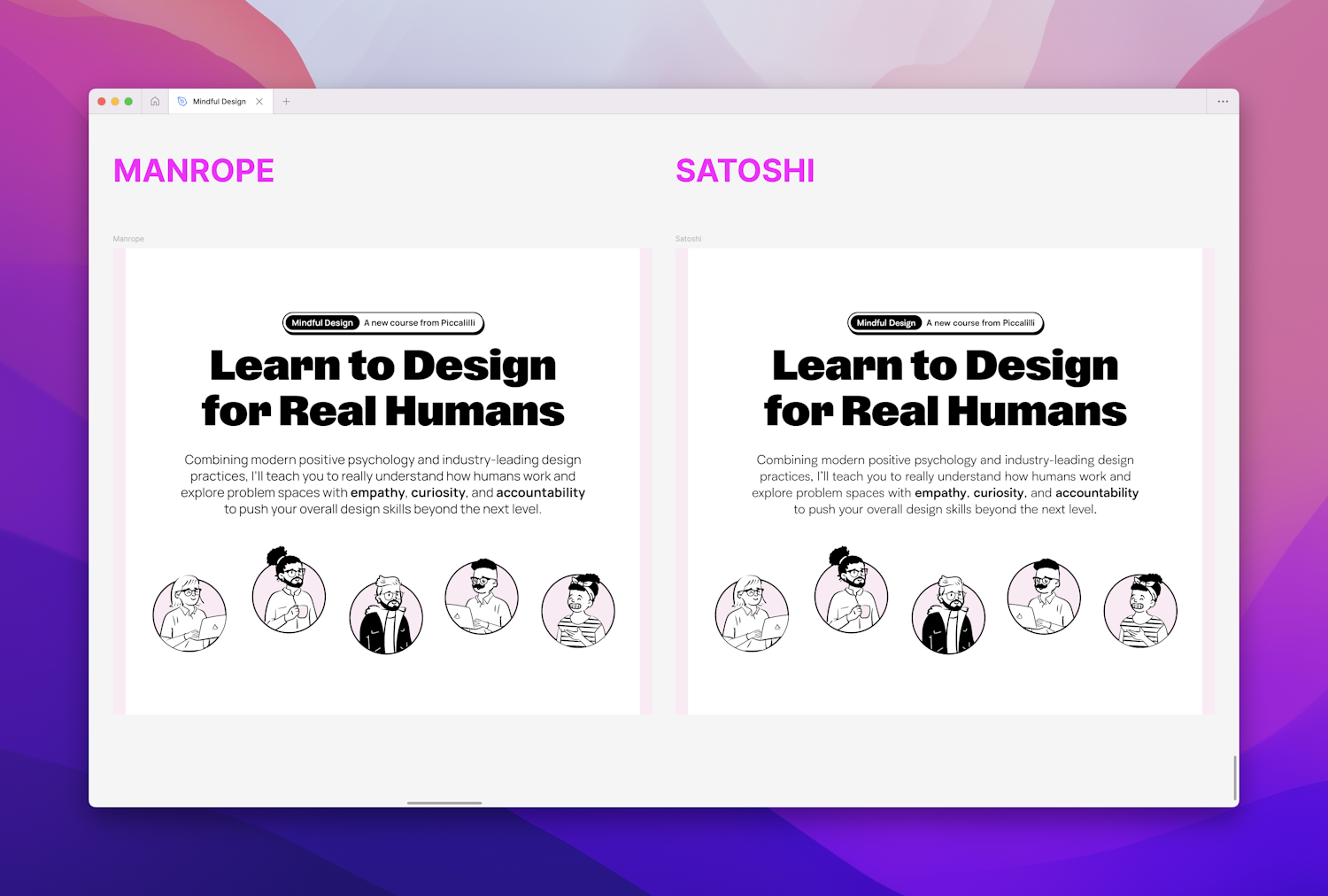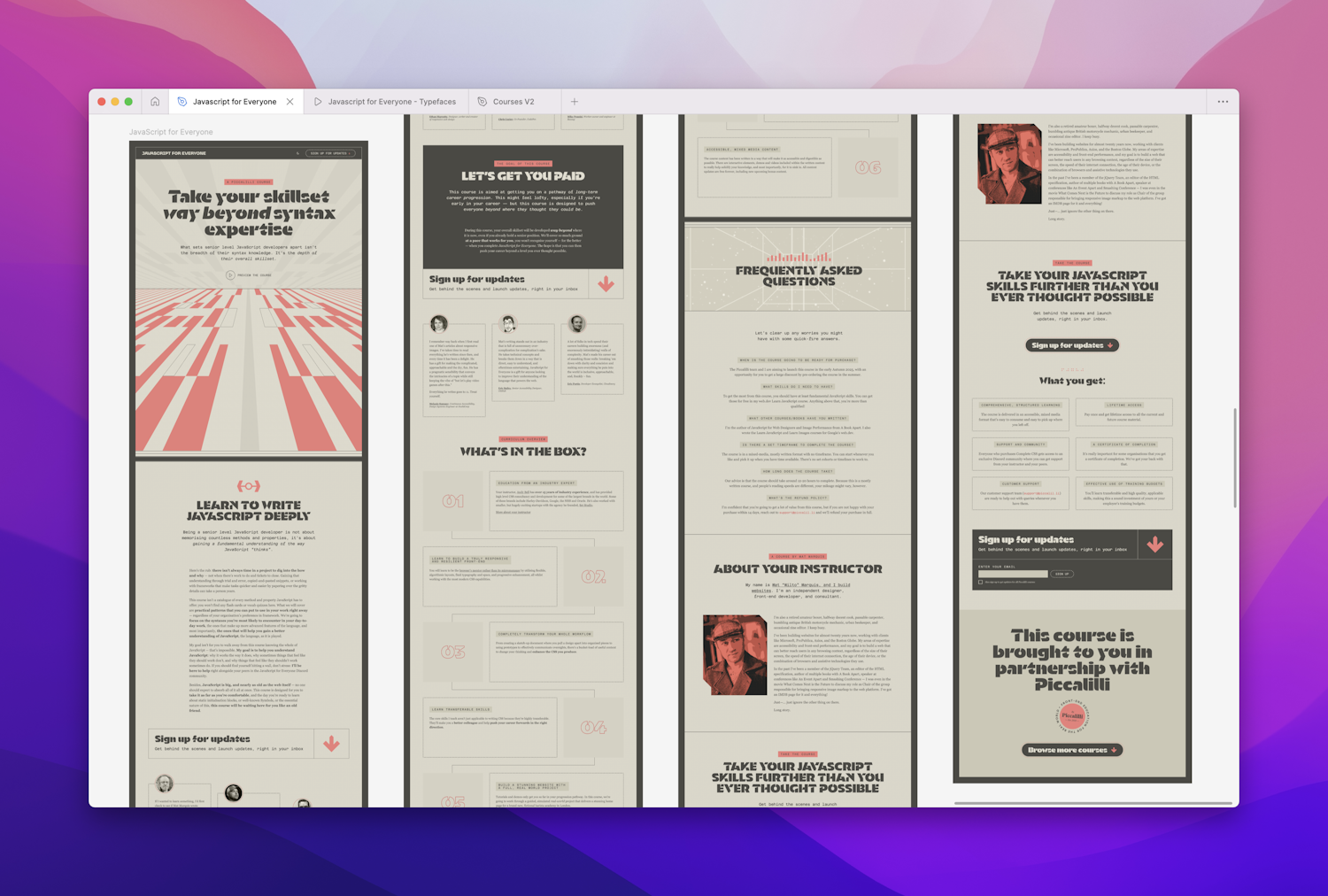Dealing with feedback on the creative exploration
I want to pick out a few key areas of our approach to dealing with client feedback. These are broad principles and can be applied in pretty much any project where you’re dealing with external partners.
The question of what to show, and when?
If you’ve read my last open working post, you may have noticed that I made the judgement call to get input from Scott and Mat at very different stages of the design process. Here’s a reminder of what was presented to each of them:


My approach to getting that first feedback on a creative direction is to bring a client or external partner in at the point when you’re confident enough in what you’re presenting to know you’re onto something, but early enough to allow time to change course if needed.
How early that feedback point tends to be in the process for me is usually fairly tied to the scale of change in the design. If it’s an existing project or brand (as with Scott’s Mindful Design course), there’s a much smaller risk to the project to take the design further before seeking feedback. But for from the ground up design — especially anything where you’re establishing a brand look and feel — getting input on the creative direction early could save a lot of time.
The framing around this first point of feedback is so important, too. We want to remain firmly in control of the project during feedback windows, and that’s a bit of an art. One I haven’t always got right, I must add! We’re all learning from experience.
A big principle we hold on to at Set Studio is to only show what we need to show to get the feedback we need. We also don’t ask for permission by asking for sign-off. Instead we’ll say something along the lines of “we’re planning to move forward in this direction unless there’s something specific that doesn’t feel right to you”.
We’ll also highlight specific areas we need their input on, keeping the focus on the decisions we’re asking a client to make. This ensures we stay in control because if we don’t do that, we end up turning into human paintbrushes, even for the most reasonable clients. We want to foster a spirit of collaboration, without compromising our role as the design partners in the relationship.
Presenting work via video also helps avoid putting the client on the spot on a call, which can often result in shallow or reactionary “feedback under pressure”. We’re trying to avoid creating a situation where the client feels they have to respond right there and then.
Here’s a typical idea of how we might present a piece of work to a client…
An example of a neutral interaction
- Me
Hi Scott I wanted to give you a preview of where we're at with the Mindful Design landing page design. I've attached a video running through the design. This is the feedback we need at this stage:
- New body font: I've kept quite close to your implementation of the Mindful Design brand, as we're big fans of what you've done — that display font is working so well. Love the little logo mark too. The only change to the look and feel was to introduce a new body font. I've used Satoshi, which is full of personality. It's got a playful swing to it that really complements the illustrations and the sharply designed but also not taking itself too seriously tone. We're really pleased with how this change brings the typographic tone much more into line with the friendliness that comes across through the messaging and illustrations. All that we need from you is a confirmation that the new typeface feels in line with the kind of tone you want to set for the Mindful Design brand before we go any further?
- UI design: In terms of the UI, we’re really confident that we've got a direction here that's working well, so we'll continue in this direction unless there's anything that you feel isn't hitting the tone you're looking for. Please bear in mind that the design will go through a prototyping phase, where we'll be evolving it according to what works best in the browser, so not everything we explore here will end up in the final product.
We made some subtle tweaks to Scott’s course brand — mainly introducing a new body typeface, to dial up the personality a notch. It’s a very subtle change, but one that I felt helped bring the typographic tone much more into line with the friendliness that comes across through the messaging and illustrations. We’ve been specific with what we’re asking for input on, whilst not inviting open feedback.

Avoiding open-ended feedback
We frame our request for feedback as a response to a clearly defined aspect of the design direction, rather than asking for open-ended feedback. Like I mentioned earlier, we’re saying that this is the direction we’re planning to go, but we’re giving the opportunity for the client to let us know if we’re barking up the wrong tree.
This approach to feedback requests helps prevent open-ended or unfocused feedback, which can easily veer a project off-course. It also establishes a sense of confidence in our design decisions, which can help a client to feel at ease. Of course, having confidence in your design decisions doesn’t mean your perspective is always “right”, which is why checking in is so important. Essentially we’re getting a temperature check before going any further.
We got a big thumbs up from Scott on both counts here, so that’s a win!
Dealing with feedback
The feedback we received from Mat was also really positive. I’ll skip a step here and jump to the feedback on the full landing page design, as the general gist of the first round of feedback was “Oh hell yes—proceed!”, which made me very happy!
An example of a neutral interaction
- Mat
Oh, excellent. First thought: rad
- Mat
The display font is giving me a little trouble once it goes further than short-and-punchy. The short all-caps headings are immaculate, as far as I'm concerned but the longer headings I find myself squinting at a little.
- Mat
Extremely unlike me, honestly, but I'm digging the over-the-top-ness of the all caps treatments
- Mat
I wonder if the similar blockiness of https://simplebits.shop/products/cartridge might work for some of the longer headings?
- Mat
I might just need to sit with it for a bit, though; don't take this as me foisting to-dos—and definitely don't read any of that as “I demand this font be used”
- Me
No worries, thanks Mat. And yeah do sit with it!
Navigating feedback like this — where very specific ideas are being suggested — is something that is best handled with a quick acknowledgement and some time and space. It’d be easy to dive into responding directly in the chat. But by letting the client sit with it, it helps give time for us both to give the feedback some proper reflection.
This approach helps keep the relationship on the footing of a collaborative partnership between designer and client, not a pixel pushing exercise. Quick tweaks are often requested and made with good intentions on both sides, but can very quickly end up derailing a design or taking a project out of scope. Mat was clearly not looking to tell us what to do here in the slightest, but even so, it would be tempting to open up Figma right away and start tweaking the design.
Here’s the design iteration I followed up with, after chatting with Mat some more and giving myself some time to sit with the feedback. My focus at this point was in addressing the areas of improvement Mat had raised, rather than the solutions that were proposed. I was keen to see if we could improve those areas with the fonts we were already using.
And here’s the full landing page design:

An example of a neutral interaction
- Mat
I am with you one hundred percent. The headline copy changes, lede weight change, and boxed secondary headings cover my type concerns completely and no sentiment on Earth could possible resonate with me more than “no half-measures.”
Lovely feedback! Although I do feel like with Scott and Mat as our “clients” here I’m kind of cheating when it comes to talking about how to deal with feedback — because they’re so kind, and because they both work in our industry so they get how to give feedback in a way that helps move us toward something better. Honestly it’s a lot of fun designing for both of them.
Loading, please wait…
Powered by Postmark - Privacy policy
Our aim with open working projects is to provide progressive movements with excellent web experiences and to also provide the tech community with elite, real world education.
We can only do this with your support though! For us to continue delivering this work, we need to replace our revenue from commercial client projects. Your support with either a pay what you can afford monthly donation, or a one-off donation will go a long way to doing exactly that.
Support Piccalilli
and see how we’re planning to make a genuine, positive impact